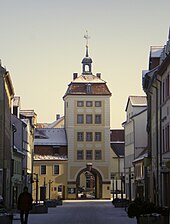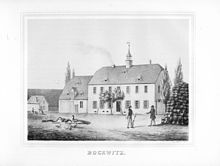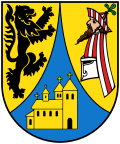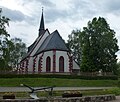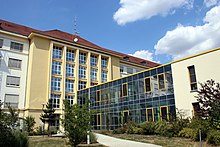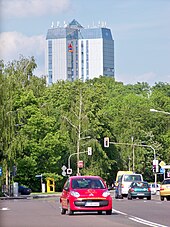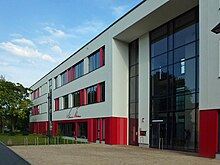Borna
| coat of arms | Germany map | |
|---|---|---|

|
Coordinates: 51 ° 7 ' N , 12 ° 30' E |
|
| Basic data | ||
| State : | Saxony | |
| County : | Leipzig | |
| Height : | 159 m above sea level NHN | |
| Area : | 62.44 km 2 | |
| Residents: | 19,118 (Dec. 31, 2019) | |
| Population density : | 306 inhabitants per km 2 | |
| Postal code : | 04552 | |
| Area code : | 03433 | |
| License plate : | L , BNA, GHA, GRM, MTL, WUR | |
| Community key : | 14 7 29 050 | |
| LOCODE : | DE BOX | |
| City structure: | 3 localities | |
City administration address : |
Market 1 04552 Borna |
|
| Website : | ||
| Lord Mayor : | Simone Luedtke ( The Left ) | |
| Location of the city of Borna in the Leipzig district | ||
Borna is a large district town in Saxony , about 30 km south of Leipzig . The city is the administrative seat of the district of Leipzig .
geography
Geographical location

Borna is located in the southern part of the Leipzig lowland bay , in the natural area of the mining area south of Leipzig . The small river Wyhra flows through the city, which previously meanders through the Wyhraaue nature reserve. In today's area around Borna, extensive lignite deposits emerged in the Tertiary , the extraction of which in open-cast mining has significantly shaped the landscape over the past 100 years. Mountains emerged from the spoil heaps of the opencast mining outcrops, and the flooding of the opencast mining holes became the Leipzig New Lakeland .
To the southeast of Borna is the Kohrener Land , a scenic and culturally attractive area.
The city is located in the middle of the metropolitan region of Central Germany , so Leipzig is 33 km, Gera 50 km, Chemnitz 58 km, Halle 67 km, and Dresden 113 km away. Neighboring larger cities are Altenburg 17 km, Grimma 24 km and Zeitz 35 km away.
Neighboring communities
The following cities and municipalities border the city of Borna:
|
Neukieritzsch , OT Lobstädt
4 km |
Rötha , OT Espenhain
8 kilometers |
Kitzscher
8 kilometers |
|
Neukieritzsch , OT Deutzen
6 km |

|
Frohburg , OT Flößberg
10 km |
|
Regis-Breitingen
9 km |
Haselbach , Treben , Fockendorf
9 km |
Frohburg
10 km |
City structure
The city of Borna is divided into the urban area with the districts that were incorporated before 1990 into the village of Eula in the north and Wyhratal in the south. Both localities have their own local council.
| Localities | Districts |
|---|---|
| Borna | Borna, old town Borna with Wenigenborna, Gnandorf, Haulwitz (historical), corridors of the places Görnitz, Hartmannsdorf, Witznitz and the Gut Bockwitz |
| Eula | Eula, Gestewitz, Haubitz, Kesselshain |
| Wyhratal | Neukirchen-Wyhra (with Neukirchen and Wyhra), Thräna with corridor by Blumroda , Zedtlitz (with Plateka and Raupenhain) |
history
City history
In today's urban area of Borna there were first the two settlements of Altstadt Borna and Wenigenborn (a) with an Augustinian canon monastery that existed until 1307 . Before the city was founded, the Borna moated castle had existed in the city since the 9th century . Under the protection of this castle, an early urban complex around today's Königsplatz developed as a market in the 11th century. The first mention of the planned market establishment of Borna west of the old town of Borna was made in 1200 in a document from Margrave Dietrich and in 1228 in a document from his son Heinrich the Illustrious . Borna was first mentioned as a town in 1251. In the wars of the Middle Ages , Borna was badly destroyed every time and burned down five times. Important military and salt roads ( B 93 and former B 95 ) ran through the town . In the 12th century there was a merchant settlement near the old town, which also included the Kunigunden Church. This church is one of the best preserved Romanesque brick buildings from the 12th century in Central Germany. In the 14th century the town hall, the town church of St. Marien and the town wall with its four gates were built. Of the gates (Reichstor, Pegauer Tor, Roßmarktsches Tor, Altenburger Tor) only the Reichstor remained, in which the city museum is located today. Economically, agriculture has always dominated, especially the cultivation of onions , which earned the city the nickname "Zwibbel-Borne". The Schriftsässigkeit received city Borna with a Lehnsbrief 1494 awarded. Already in 1464 the city of Borna received the lower and 1482 the high jurisdiction upon revocation. The manorial power lay with the city council of Borna. After the town regulations were introduced in 1832, the Borna district included the town with its suburbs, the Bockwitz manor and the Haulwitz suburb. The city's jurisdiction was transferred to the Royal Saxon District Court of Borna in 1854.
Famous guests of the city were: Martin Luther 1522, Tsar Alexander I. 1813, Napoleon Bonaparte . The garrison of the carbine regiment was in Borna until 1918 , which formed the 4th Saxon cavalry brigade with the Uhlan regiment No. 21 . Next to the town hall there is still the old guard , which served the soldiers as a guard house. A horse virus is named after the city, the Bornash disease virus (also BoDV - Borna Disease Virus) of the Bornaviridae family , because the disease it caused was first described in the city's cavalry horses in 1885. In 1908 a very well-preserved mammoth skeleton was found near the city , which was then called the Borna mammoth and exhibited in the Museum für Völkerkunde in Leipzig until it was almost completely burned in December 1943 as a result of a bomb attack.
With the start of lignite mining around 1800, the city's industrialization began . The lignite industry dominated until recently. In the 19th century, however, other companies such as the piano maker Heyl came into being . On January 14, 1867, at the insistence of Mayor Karl Heinrich , Borna was connected to the German railway network by building the Borna– Neukieritzsch line, and thus in Neukieritzsch to the Leipzig – Hof (Saxon-Bavarian Railway) line to Leipzig . This rail connection was financed by private funds and the city treasury and was therefore the only urban railroad in the Kingdom of Saxony . On April 8, 1872, the line via Geithain to Chemnitz was extended ( Neukieritzsch – Chemnitz line ). As a result, at the beginning of the 20th century the city initially expanded westwards towards the train station. Later settlements emerged in the southwest. The Witznitz I and II , Borna-West and Borna-Ost / Bockwitz opencast mines were built around the town . As a result, today's districts of Alt-Witznitz (large part), Görnitz with Hartmannsdorf, Blumroda, Gut Bockwitz and Borna-Ost (abbey) were devastated. In return, the districts "Neu-Witznitz" behind the Breite Teich, "Borna-Nord" (from 1950) and the new building areas "Am Hochhaus", "Borna-Ost", "Borna-Südwest" and "Paul-Paschke" emerged from 1950 -Straße "(today:" An der Wyhra "). The Gnandorf development area was the last to be built in 1984. After 1990, renovations mainly took place in the city center.
Borna has always been the center of administration. Until 1856, the city was the capital of the Electoral Saxon or Royal Saxon Office Borna in the Leipzig district . From 1856 the place was the seat of the Borna court office and from 1875 the Borna district administration , which was called Borna district from 1939 to 1952. The administrative reform of 1952 made Borna district town of the Borna district in the Leipzig district , which was continued as the Borna district in 1990. With the district reforms in the Free State of Saxony, Borna received the municipal status of a large district town on October 1, 1994 , but initially lost the district seat of the district of Leipziger Land , which was created by merging the districts of Leipzig-Land, Borna and Geithain, to the district-free city of Leipzig. From January 1st, 1999 the district seat was again in Borna. Even after the merger of the previous district of Leipziger Land with the Muldental district in 2008, Borna remained the district town of the newly created district of Leipzig.
History of the districts incorporated before 1990
Old town Borna with Wenigenborna and abbey
The city of Borna originally consisted of three settlement centers. In addition to the planned market settlement of Borna, which was first mentioned in 1228 (attested as a town since 1264), this was the old town of Borna east of the Mühlgraben with Borna Castle and Wenigenborn (a). Wenigenborn, also known as Wendisch-Born in the early days, is the oldest of the three settlements. An Augustinian canon monastery existed in the place between 936 and 1307 . Borna old town had its own church called Johanniskirche until 1539. In the course of the Reformation , the dilapidated church was demolished and the old town of Borna and Wenigenborna parish to Borna. In 1530 Borna Castle, which was expanded into a castle in the 12th century, was demolished. Since the 16th century, the towns of Borna and Wenigenborna, separated by the Saubach, formed a legal entity that was subordinate to Borna. In the place was the Official Frohn Festival (official prison) of the Borna office. Although Old Town Borna had no suburban qualities, the place was referred to as the suburb of Borna around 1724 and 1834. In 1934, the old town of Borna with Wenigenborna and the district Abtei were incorporated into Borna to the west. The Abtei district was relocated between 1964 and 1966 due to the approaching Borna-Ost opencast mine and dredged between 1966 and 1968.
Bockwitz, good
In Bockwitz, north-west of Borna, a manor had been recorded since 1292, which was called a knight's seat from 1420. Bockwitz was parish in the old town of Borna until 1539. In the period that followed, the village and the knight's seat were desolate. Not until 1791 was a manor named again that belonged to the Borna office. It was referred to as a Burglehngut in 1834 and a Rittergut in 1858. Bockwitz was parish in Borna since 1834 and in St. Marien parish in Borna since 1875. In 1854 the Bockwitz estate was incorporated into Borna. The manor was dissolved in 1945 and the corridor was divided among new farmers .
Lignite mining around Bockwitz began in the mid-19th century. The first attempts at drilling began in 1835. A few decades later, seven pits were in operation north of the town. Around 1870 there were several underground mines as well as the Kunze, Bauer and Gottessegen opencast mines. The Borna-Ost opencast mine (1960–1985) reached the southern edge of the village in construction site II in 1970/71, but spared the place itself. This changed with the opening of the Bockwitz opencast mine in 1982 southwest of Bockwitz. In preparation for the northward expansion of the mining field, the Bockwitz location was cleared in 1988, but was no longer excavated due to the early closure in 1992. After the renaturation of the area, the Bockwitz corridor is now on the northwestern edge of Lake Bockwitz .
Gnandorf
Gnandorf is located south of Borna city center between the Neukieritzsch-Chemnitz railway line in the west and the Wyhra in the east. The place celebrated its 625th anniversary in 2003. The place was in the Borna office and was subject to the inheritance jurisdiction of the Borna City Council until 1856. In 1856 this passed to the Borna court office. Since 1875 the place belonged to the administrative authority Borna. Gnandorf was incorporated into Borna in 1934. On August 17, 1984, the foundation stone was laid for the Gnandorf development area.
Görnitz with Hartmannsdorf
Görnitz belonged to the Lobstädt manor until 1855/56 , Hartmannsdorf to the Großhermsdorf manor . Both places were in the Saxon office of Borna. In 1856 they came to the Borna court office and in 1875 to the Borna district administration. On October 1st, 1948 Hartmannsdorf was incorporated into Görnitz. In the course of the lignite mining in the Borna-West opencast mine , Hartmannsdorf was partially dredged between 1957 and 1960, while Görnitz was completely dredged between 1961 and 1963. Today the Borna reservoir is located on the recultivated area of the villages. The area has belonged to Borna since 1965.
Haulwitz
The Haulwitz Vorwerk has been documented since 1791. At that time it was under the jurisdiction of the manor Lobstädt in the Borna district. After the introduction of the city code in the Kingdom of Saxony, Haulwitz came to the Borna city court district in 1832. In the following years Haulwitz went on in the urban area of Borna. Today Haulwitzer Straße is located in the southwest of the core city of Borna.
Witznitz
The place Witznitz was north of Borna and southwest of Haubitz. In 1548, jurisdiction over the place in the Borna district lay with the Lobstädt manor . In 1764 there was an own manor in the village. In 1856 Witznitz came to the Borna office and in 1875 to the Borna administration. The Witznitz I opencast mine was in operation from 1911 to 1949. In preparation for the impending demolition of Witznitz due to the open pit, the place was incorporated into Borna in 1940. In 1941 the place was demolished. Between 1950 and 1954, the Witznitz reservoir was built in the disused open-cast mine , with a few houses from Alt-Witznitz remaining on its southwestern edge. The district "Neu-Witznitz" was created on the northern edge of Borna behind the broad pond.
The Witznitz briquette factory east of the Witznitz storage basin was in operation until 1992. A re-use concept was drawn up for them. The creation of the new Borna residential area "Grüne Harfe" is planned on the site, which will integrate new apartments and the old factory buildings. The aim is mixed use with a focus on education / culture / leisure, trade and living. Despite the dismantling and the removal of all the technology, the eleven buildings made of yellow clinker brickwork have been preserved and four have already been renovated. As a high-quality testimony to industrial architecture, they now house offices and are used for exhibitions and cultural events. Another building was converted into a residential location for lofts . The area of the former rail connection has already been built on with single-family houses.
Incorporations
Haulwitz belongs to Borna after 1832. The Bockwitz estate was incorporated in 1853/1854. In 1934 old town Borna and Gnandorf were incorporated. Witznitz was incorporated in 1940 and Görnitz with Hartmannsdorf was added in 1965. The three places Witznitz, Görnitz and Hartmannsdorf were eliminated by the lignite mining.
The municipality of Eula with its four districts was incorporated in 1994. In 2004, Wyhratal followed with four districts. Eula and Wyhratal have their own local council.
| Former parish | date | annotation |
|---|---|---|
| Old town Borna with Wenigenborna | April 1, 1934 | Abtei district devastated between 1964 and 1966 by open-cast lignite mining on Borna-Ost |
| Blumroda | January 1, 1960 | Incorporation of the corridor to Thräna, removed from 1952–1957 by open-cast lignite mining Borna-West (today Borna reservoir) |
| Bockwitz, good | 1853/1854 | Removed in 1988 by the Bockwitz open-cast lignite mine |
| Eula | March 1, 1994 | |
| Gestewitz | April 1, 1935 | Incorporation after Eula |
| Gnandorf | April 1, 1934 | |
| Görnitz | January 1, 1965 | 1961–1963 cleared by open-cast lignite mine Borna-West (today Borna reservoir) |
| Hartmannsdorf | October 1, 1948 | Incorporation to Görnitz, 1957–1960 removed by open-cast lignite mining Borna-West (today Borna reservoir) |
| Howitzer | September 1, 1948 | Incorporation after Eula |
| Haulwitz | 1840 | |
| Kesselhain | before 1880 | Incorporation after Eula |
| Neukirchen | October 1, 1948 | Merger with Wyhra to Neukirchen-Wyhra |
| Neukirchen-Wyhra | 1st December 1993 | Merger with Zedtlitz zu Wyhratal |
| Plateka | before 1880 | Incorporation to Zedtlitz |
| Caterpillar grove | before 1880 | Incorporation to Zedtlitz |
| Thrana | July 1, 1997 | Incorporation to Wyhratal |
| Witznitz | October 1, 1940 | In 1941, most of it was eliminated by the Witznitz I open-cast lignite mine (today the Witznitz storage facility), Alt-Witznitz on the southwestern edge of the storage facility, the Grüne Harfe settlement on the eastern edge |
| Wyhra | October 1, 1948 | Merger with Neukirchen to Neukirchen-Wyhra |
| Wyhratal | January 1, 2004 | |
| Zedtlitz | 1st December 1993 | Merger with Neukirchen-Wyhra zu Wyhratal |

coat of arms
The coat of arms of the city of Borna is a three-part shield with the basic colors gold and blue. In the first field the coat of arms shows the black Meißner lion facing to the right, in the second field a silver helmet with a crest. This consists of a red and silver striped male trunk, the so-called Meißner Jew head. His bearded head wears a red and silver striped cap, which is decorated with a peacock feather. In the blue top of the coat of arms stands a golden church with three towers.
These three coats of arms go back to the tradition of the oldest city seal. The tiny lion and the helmet with the Jewish hat can already be recognized there - both also had the Margraves of Meißen in their coat of arms, and with them the city documented its membership of the Margraviate of Meißen. In the middle of the seal, however, dominated a large, three-tower church, which was determined by the historian Prof. O. Kittel as a symbol of the diocese of Merseburg, in whose area our city developed. Borna derived its city colors gold and blue from the family arms of the House of Wettin. They belonged to the Osterland and the Mark Landsberg and we also see them in the Leipzig city arms as the blue and gold “Landsberger Pfähle”.
Before the coat of arms got its present form, a brightly painted, enlarged form of the city seal had been in use since 1845, which contradicted all the rules of heraldry, so that the Ministry of the Interior demanded changes. This coat of arms on the precious coffered ceiling of the council chamber in the town hall can be seen as a curiosity. In August 1897 the coat of arms, by the Königl. Saxon. Ministry of the Interior officially confirmed and has remained unchanged since then.
Residents
|
(as of December 31st)
|
politics
City council
Since the municipal council election on May 26, 2019 , the 22 seats of the city council have been distributed among the individual groups as follows:
Lord Mayoress
The Lord Mayor is Simone Luedtke (Die Linke).
Town twinning
-
 Étampes , France
Étampes , France -
 Irpin , Ukraine
Irpin , Ukraine -
 Dujiangyan , People's Republic of China
Dujiangyan , People's Republic of China -
 Shangcheng (Hangzhou) , People's Republic of China
Shangcheng (Hangzhou) , People's Republic of China
Children's and youth parliament
Since 2008 there has been a youth parliament in Borna, which since a statute change in 2012 now represents the interests of the youth towards the city as a children and youth parliament (KiJuPa). The child and youth parliament is made up of a maximum of fifteen elected members and two each from the two secondary schools and has the right to speak and propose to the city council.
Culture and sights
Museums
- Borna City Museum
- Wyhra Folklore Museum
Buildings
- Market square with town hall (1669–1676), "Alter Wache" (Borna tourist and town information center) and "Goldener Stern" community center
- Martin Luther monument next to the two churches on Martin Luther Platz, also commemorating the Ash Wednesday letter that Luther wrote in 1522 to Elector Friedrich the Wise in Borna
- Stadtkulturhaus (former theater )
- Reichstor (1723), the last of four city gates, remains of the city wall have also been preserved
- Volksplatz Borna , an open-air stage in the style of an amphitheater with almost 10,000 seats and Europe's largest fixed film wall
- High school "Am Breiten Teich" (built 1907–1908 as the Royal Realgymnasium Borna )
- Witznitz briquette factory (1912), closed in 1992, today a place for events and living
- Briquette factory in Neukirchen
- New dutch mill Wyhra
Memorials
- Honor grove on Lobstädter Strasse for 98 Jewish concentration camp prisoners from the Flößberg subcamp of the Buchenwald concentration camp who were victims of forced labor at Hugo Schneider AG (" HASAG ")
- Memorial stone in front of the former high school in memory of the resistance fighter Georg Schwarz
Churches
- City church St. Marien with the late Gothic winged altar by Hans Witten .
The basement of the tower dates from the middle of the 13th century . In 1411 the choir was rebuilt, in 1455 the pillars and vaults of the nave . On October 16, 1456, the Merseburg bishop inaugurated the building. The winged altar is a testimony to the late Middle Ages and bears the date of creation 1511 above the center shrine. In 1555 the tower was raised. During the Battle of the Nations near Leipzig , the church served as a military hospital; after various renovations, it now characterizes the oldest part of the city.
- Emmaus Church in Heuersdorf .
The place was west of Borna and was destroyed by the United Schleenhain opencast mine until 2010 . The residents lost their homes. In order to save this cultural asset, the church was moved from Heuersdorf to Borna in 2007 on 160 wheels of a special truck. The Romanesque church from the 13th century is intended to be a meeting place for former residents, as well as being used for church services and public admission. The church is fully furnished and contains a plaque with the places that fell victim to the open pit. A crib is set up at Christmas time. It is open every day, and visitors can take documents with them in return for a donation.
- Kunigunden Church (Romanesque basilica , one of the earliest brick buildings in Central Germany)
- Wiprecht Church in Eula
- Catholic Church of St. Joseph in Staufenbergstrasse, formerly a casino until 1919
- Church of the Free Evangelical Church
- New Apostolic Church in Oststrasse
Regular events
- Subscription and matinee concerts by the Leipzig Symphony Orchestra
- Summer spectacle
- City festival
- Event shopping
- Christmas Market
- New Lakes Classics
- 7 lakes hike
- Luther Run and Luther Festival
- Onion run
- French emotions
freetime and sports
There are several sports halls and sports fields in Borna and its districts. The most modern sports facility in the city is the Glück-Auf sports hall, which, together with the Rudolf Harbig Stadium, where the Bornaer SV 91 plays its home games, belongs to the Borna-Nord sports center. There is also a hockey rink and tennis court in the city. Since it was converted into a swimming center, the municipal swimming pool has been called “Jahnbad Borna”.
The urban area of Borna is surrounded by several lakes belonging to the Leipziger Neuseenland . The Borna reservoir ("Adria") is a body of water for swimming, fishing and surfing. Due to the length of the crown of 6500 m, it is one of the largest dams on earth . You can also go fishing and swimming at Lake Bockwitz to the east . Large parts of the lake are designated as a nature reserve due to the biodiversity in nature and landscape. To the north of Borna are the Witznitz reservoir , the Haubitzer See and the Hainer See , which emerged from the Witznitz I and Witznitz II opencast mines. The Harthsee is also not far from the Neukirchen district .
Borna is a station on the Lutherweg Sachsen . Furthermore, the Neuseenland Cycle Route and the Wyhratal Cycle Route run through the city.
Economy and Infrastructure
The city's largest employer is the Borna Clinic, which, along with the Zwenkau Hospital, is part of the Sana Kliniken Leipziger Land . The Leipziger Land clinics are a basic and standard care hospital and currently have 480 beds in ten bed-managing specialist departments with eleven chief physician-led clinics and institutes. The clinic is the academic teaching hospital of the University of Leipzig .
In Borna, several large-scale solar power plants have been connected to the grid in recent years .
As already mentioned, the lignite industry has been the dominant branch of the economy in Borna since the discovery of the deposits until almost all of this type of business was closed due to unprofitability after the fall of the Wall.
traffic
Transportation
The city lies in the network area of the Central German Transport Association . Borna is located with its districts and districts, the Neukieritzsch district Deutzen and the towns of Kitzscher and Regis-Breitingen in tariff zone 153. A connection to the rail network has existed since 1872 via the Neukieritzsch – Chemnitz railway line , that of the Leipzig – Hof railway line in Neukieritzsch branches off. The Borna train station (near Leipzig) and the Petergrube and Neukirchen-Wyhra stops are located in the Borna urban area . Since the opening of the City-Tunnel Leipzig on December 15, 2013 Borna has been connected to the network of the S-Bahn Central Germany and is connected to Leipzig by S-Bahn line 6 every 30 minutes.
Borna is connected with three PlusBus and other regional bus routes through the Leipzig regional bus and the THÜSAC local passenger transport company . Among other things, there are various destinations in the Leipzig district and in the Altenburger Land district in the Free State of Thuringia . The town bus Borna wrong with the lines A and B . You drive through the urban area in a ring line, offset by half an hour from one another. On weekends, both lines run alternately every two hours. At its terminus at Borna train station, the journeys are geared towards the S-Bahn.
Road traffic
The city is connected to the trunk road network via the federal motorway 72 with the junctions Borna-Nord and Borna-Süd . A few kilometers north of the city is also the A 38 , up to which the A 72 will run in the future.
In addition, Borna is at the intersection of the B 93 , B 95 and B 176 federal highways .
media
Since 1995 the local television station Regio-TV has been sending weekly updated news for Borna and the surrounding towns and communities. The Leipziger Volkszeitung is the only regional daily newspaper published in Borna. The Borna-Geithain local editorial office is located on Brauhausstrasse.
Public facilities
As a medium-sized center and district town, Borna houses numerous public institutions. The city is the administrative seat of the district of Leipzig and the district craftsmen. There is also an office of the employment agency and the municipal job center in Borna. The police station in the Grimmaer road belongs to the police department of Leipzig, the district court Borna is the district court Leipzig downstream. The regional association of Saxony, Thuringia of the Technical Relief Organization has had a local association in Borna since 2003.
Educational institutions
schools
- General education schools:
- Primary School Borna-West (formerly Karl-Marx- Oberschule )
- Primary school " Clemens Thieme " (opened in 2013, successor to the Borna-Nord primary school, formerly POS Georg Schwarz , and the Neuseenland primary school)
- Elementary school Neukirchen
- Dinter high school
- High school "Am Breiten Teich"
- Special schools:
- Robinienhofschule Borna
- School to promote learning Borna
Media library
The first public library in Borna was opened as a municipal facility as early as 1877. In 2011, the city library and the district library of the Leipzig district were merged to form the Borna media library, which is located in the building on Martin-Luther-Platz. In the following year, a two-storey extension was opened on the existing building, which was necessary to accommodate the expanded media inventory. From there, the associated mobile library supplies various stops in the Leipzig district with a wide range of media.
Personalities
literature
- Richard Steche : Borna. In: Descriptive representation of the older architectural and art monuments of the Kingdom of Saxony. 15. Issue: Amtshauptmannschaft Borna . CC Meinhold, Dresden 1891, p. 7.
- Borna . In: August Schumann : Complete State, Post and Newspaper Lexicon of Saxony. 1st volume. Schumann, Zwickau 1814, pp. 452–454.
- Christian environmental seminar Rötha eV, Kulturbüro Espenhain, Heimatverein Regis-Breitingen und Umgebung eV (Ed.): Memories of the villages of Blumroda, Hartmannsdorf , Görnitz , Deutzen and Schleenhain . Regis-Breitingen 1996, ISBN 3-930044-07-2
- Stefan Hänsel: Borna local family book (near Leipzig) 1548–1631. Berlin: epubli 2015, ISBN 978-3-7375-3043-9 , 4211 families, based on the manuscript (1971) by Martin Engelmann and Hans Luther: Church book of the city of Borna 1548–1608, which already contains 3000 families
- Stefan Hänsel: Ortsfamilienbuch Neukirchen bei Borna 1580–1793. Berlin: epubli 2014, ISBN 978-3-8442-9665-5 , 592 families
- Stefan Hänsel: Ortsfamilienbuch Wyhra 1575-1799. Berlin: epubli 2012
- An extensive tradition of the Borna City Court for the period 1518–1854 on court and local administration, criminal, civil and voluntary jurisdiction, feudal matters, detachments, court books and court records is in the Saxon State Archives, Leipzig State Archives, inventory 20598 Borna City (City Court) .
Web links
- City of Borna
- Borna in the Digital Historical Directory of Saxony
- Borna City Museum
- Experience Borna in a 360-degree panorama
Individual evidence
- ↑ Population of the Free State of Saxony by municipalities on December 31, 2019 ( help on this ).
- ^ The Borna City Court in the State Archive of Saxony
- ^ The town history of Borna on stadtegutschein.de, accessed on November 16, 2015
- ^ Karlheinz Blaschke , Uwe Ulrich Jäschke : Kursächsischer Ämteratlas. Leipzig 2009, ISBN 978-3-937386-14-0 ; P. 62 f.
- ^ The Borna District Administration in the municipal directory 1900
- ↑ History of the Johanniskirche in old town Borna
- ↑ History of the official Glad festivals in Altstadt Borna
- ↑ Old Town Borna in the Historical Directory of Saxony
- ↑ Description of the Borna-Ost opencast mine
- ^ The Bockwitz manor at www.sachsens-schlösser.de
- ↑ Bockwitz in the Historical Directory of Saxony
- ↑ Bockwitz on www.devastiert.de ( Memento of the original from November 17, 2015 in the Internet Archive ) Info: The archive link was inserted automatically and has not yet been checked. Please check the original and archive link according to the instructions and then remove this notice.
- ^ Description of the Borna-Ost / Bockwitz opencast mine
- ↑ Link to the book "625 Years Gnandorf - From Angerdorf to New Building Area"
- ^ The Borna City Court in the State Archive of Saxony
- ↑ Gnandorf the Historical Gazetteer Saxony
- ↑ Chronicle of Borna
- ^ The lobstädt manor in the state archive of Saxony
- ^ Hartmannsdorf on gov.genealogy.net
- ↑ The Borna-West opencast mine at www.devastiert.de ( Memento of the original from December 8, 2015 in the Internet Archive ) Info: The archive link was automatically inserted and not yet checked. Please check the original and archive link according to the instructions and then remove this notice.
- ^ Vorwerk Haulwitz at www.sachsens-schlösser.de
- ^ The lobstädt manor in the state archive of Saxony
- ^ The Borna City Court in the State Archive of Saxony
- ^ Haulwitz in the Historical Directory of Saxony
- ^ Witznitz in the Historical Directory of Saxony
- ↑ Description of the Witznitz opencast mine
- ↑ Mention of Neu-Witznitz in the story of Borna on stadtegutschein.de
- ↑ Description of the Witznitz Briquette Factory ( Memento of the original from November 20, 2015 in the Internet Archive ) Info: The archive link was inserted automatically and has not yet been checked. Please check the original and archive link according to the instructions and then remove this notice.
- ^ The residential area Witznitz on the website of the city of Borna
- ↑ a b c d e f g The Saxony Book, Kommunal-Verlag Sachsen KG, Dresden, 1943
- ↑ a b c d e f municipalities 1994 and their changes since January 1, 1948 in the new federal states , Metzler-Poeschel publishing house, Stuttgart, 1995, ISBN 3-8246-0321-7 , publisher: Federal Statistical Office
- ^ Bockwitz in the Digital Historical Directory of Saxony
- ↑ a b c d e State Statistical Office of the Free State of Saxony: Area changes
- ↑ Results of the 2019 municipal council elections
- ^ "Ash Wednesday letter" from Borna
- ↑ 20615 City of Borna (City Court). In: State Archives Leipzig. Retrieved March 26, 2020 . (Information on the Borna City Court under "Introduction")




